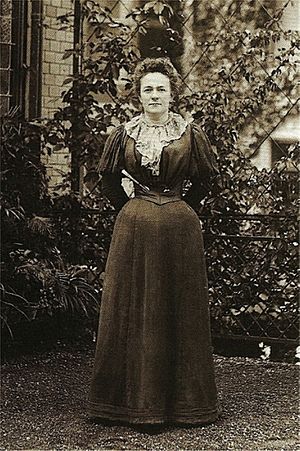Clara Zetkin facts for kids
Quick facts for kids
Clara Zetkin
|
|
|---|---|
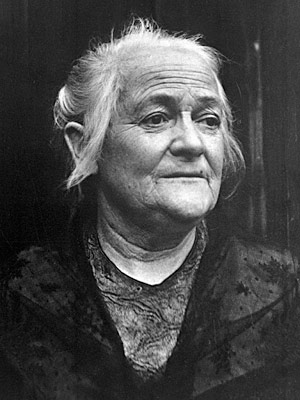
Clara Zetkin (c. 1920)
|
|
| Born |
Clara Josephine Eißner
5 July 1857 Wiederau, Kingdom of Saxony, German Confederation
|
| Died | 20 June 1933 (aged 75) |
| Resting place | Kremlin Wall Necropolis, Moscow |
| Other names | Klara Zetkin |
| Occupation | Politician, peace activist and women's rights activist |
| Political party | SPD (until 1917) USPD (1917–1922; Spartacus wing) KPD (1920–1933) |
| Partner(s) | Ossip Zetkin (1850–1889) Georg Friedrich Zundel (1899–1928) |
| Children | Maxim Zetkin (1883–1965) Konstantin "Kostja" Zetkin (1885–1980) |
Clara Zetkin (born Clara Josephine Eißner; 5 July 1857 – 20 June 1933) was an important German politician and activist. She believed in communist ideas and worked hard for women's rights and peace.
She was a member of the Social Democratic Party of Germany until 1917. Later, she joined the Independent Social Democratic Party of Germany (USPD). She was also part of the Spartacus League, which became the Communist Party of Germany (KPD). From 1920 to 1933, she represented the KPD in the Reichstag, which was the German parliament.
Contents
Biography
Early Life and Education
Clara Josephine Eißner was born in Wiederau, a small village in Germany. She was the oldest of three children. Her father, Gottfried Eissner, was a school teacher and church organist. Her mother, Josephine Vitale, came from a well-educated family.
In 1872, Clara's family moved to Leipzig. There, she studied at the Leipzig Teachers’ College for Women. During her studies, she met people involved in the early Social Democratic Party of Germany (SPD). This party worked to improve life for working people.
Because socialist activities were banned in Germany in 1878, Clara had to leave the country. She moved to Zurich, Switzerland, in 1882. Later, she went to Paris, France. In Paris, she studied to become a journalist and translator. She also helped start an international socialist group.
While in Paris, she met Ossip Zetkin, a strong believer in Marxist ideas. She adopted his last name. They had two sons, Maxim and Konstantin. Ossip became very ill and died in 1889. After his death, Clara moved to Stuttgart with her children. Later, from 1899 to 1928, she was married to an artist named Georg Friedrich Zundel.
Early Political Work
Clara Zetkin's political journey began after meeting Ossip Zetkin. She quickly became dedicated to the socialist movement. She believed that women's freedom was linked to socialist ideas.
After returning to Germany, she became the editor of Die Gleichheit (Equality). This was the women's newspaper for the Social Democratic Party of Germany. She worked there for 25 years.
Clara had studied to be a teacher. This helped her connect with both the women's movement and the labour movement in Germany. In 1878, she joined the Socialist Workers' Party. This party later became the Social Democratic Party of Germany (SPD) in 1890.
Around 1898, Clara became good friends with Rosa Luxemburg. They were both strong supporters of the far-left ideas within the SPD. They worked together to challenge those who wanted to change socialist ideas to be less revolutionary.
Fighting for Women's Rights
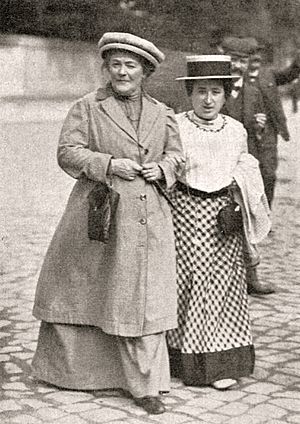
Clara Zetkin was very passionate about women's rights. She fought for equal opportunities and women's suffrage (the right to vote). She believed these goals could be achieved through socialism. From 1891 to 1917, she edited Die Gleichheit, the SPD's women's newspaper. In 1907, she became the head of the SPD's new "Women's Office."
She also played a big role in creating International Women's Day (IWD). In August 1910, an International Women's Conference was held in Copenhagen, Denmark. Clara Zetkin and others suggested that a "special Women's Day" should be held every year. They wanted this day to promote equal rights for women, including the right to vote.
The idea was agreed upon by 100 women from 17 countries. The first International Women's Day was celebrated on 19 March 1911. Over a million people in Austria, Denmark, Germany, and Switzerland took part.
However, Clara Zetkin did not agree with "bourgeois feminism." She thought this type of feminism, often led by upper-class women, would divide working-class women. She believed that the fight for women's freedom was part of a bigger social struggle. She felt that true equality for women could only happen after a complete change in society, through socialism.
She wanted women to work outside the home. This would allow them to join trade unions and other worker groups. She believed this was the best way for women to improve their lives. She argued that socialist movements should fight for reforms to help women. But she was sure that these reforms would only last if they were part of a move towards socialism.
In 1920, she interviewed Vladimir Lenin, a leader of the Russian Revolution, about "The Women's Question."
Against World War I
During World War I, Clara Zetkin was a strong voice for peace. She attended an international women's peace conference in Switzerland. There, she spoke about who truly benefits from war. She said it was only a small group: "The manufacturers of rifles and cannons... In the interests of their profits, they have fanned the hatred among the people." She argued that workers had nothing to gain from the war.
Clara Zetkin and other SPD politicians did not support the party's decision to stop strikes during the war. She organized an international socialist women's anti-war conference in Berlin in 1915. Because of her anti-war views, she was arrested several times. In 1916, she was held in "protective custody" but was later released due to illness.
Joining the Communist Party
In 1916, Clara Zetkin helped start the Spartacus League. This group later formed the Independent Social Democratic Party of Germany (USPD) in 1917. They split from the SPD because the SPD supported the war.
In January 1919, the Communist Party of Germany (KPD) was founded. Clara Zetkin joined this party. From 1920 to 1933, she represented the KPD in the Reichstag. She and Paul Levi were the first communists to enter the Reichstag.
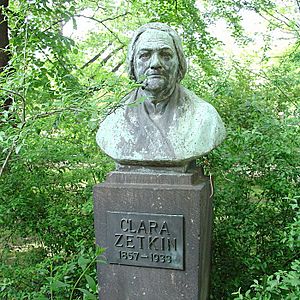
Clara Zetkin was a member of the KPD's main office until 1924. From 1927 to 1929, she was on the party's central committee. She was also part of the executive committee of the Communist International (Comintern) from 1921 to 1933. She led an international office for women, created by the Comintern in October 1920. In June 1921, the Second International Conference of Communist Women, led by Clara Zetkin, changed the date of International Women's Day to 8 March. This is still the date today.
In 1925, she became president of Rote Hilfe, a German left-wing support organization. She sometimes disagreed with Moscow's influence over the German Communist Party. In 1928, she was one of only three people to vote against a decision by Joseph Stalin in the Comintern. She kept her important position despite this.
In August 1932, even though she was very ill, she returned to Berlin. She led the opening of the new Reichstag as its oldest member. In her speech, she called for workers to unite against fascism. She said that all differences should be put aside to fight against this threat.
She received important awards, including the Order of Lenin (1932) and the Order of the Red Banner (1927).
Exile and Death
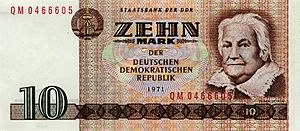

After Adolf Hitler and his Nazi Party came to power in 1933, the KPD and other opposing parties were banned. Clara Zetkin went into exile for the last time, moving to the Soviet Union.
She died there in 1933, near Moscow, at almost 76 years old. Her ashes were placed in the Kremlin Wall Necropolis in Moscow. Important communist leaders from all over Europe, including Joseph Stalin, attended her funeral.
After 1949, Clara Zetkin was celebrated as a hero in East Germany. Many cities named streets after her. Her name can still be found on maps in parts of Germany that were once East Germany. There is also a street named after her in Tula, Russia.
Works
Posthumous Honors
- Clara Zetkin was honored on the ten mark banknote and twenty mark coin of East Germany.
- After 1949, many major cities in East Germany named streets after her.
- In 1954, East Germany created the Clara Zetkin Medal.
- In 1955, the city of Leipzig named a new park "Clara-Zetkin-Park".
- In 1967, a statue of Clara Zetkin was put up in Johannapark, Leipzig.
- In 1987, East Germany issued a stamp with her picture.
- Since 2011, the German political party Die Linke gives out an annual "Clara-Zetkin-Frauenpreis".
See also
 In Spanish: Clara Zetkin para niños
In Spanish: Clara Zetkin para niños
- List of peace activists
- Alexandra Kollontai
- Nadezhda Krupskaya
- Rosa Luxemburg


